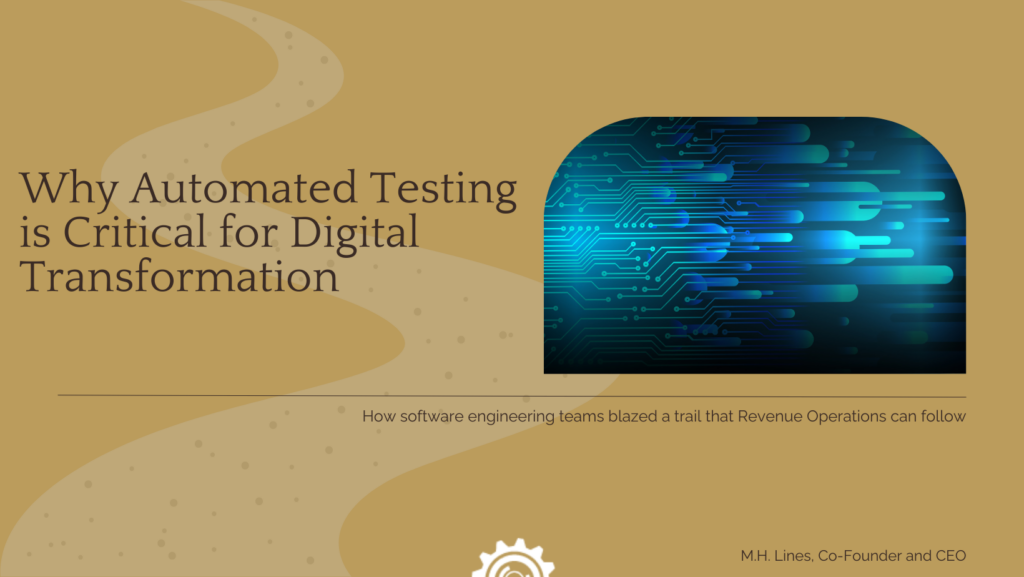Automated testing has been built into software development for 15 years. But the practice has yet to make its way into other technical teams, like Marketing Technology or Revenue Operations (RevOps). This is surprising when you consider how focused these teams can be on achieving digital transformation.
Digital transformation. Not digital rebirth. Transformation is the process of changing in character or condition. Digital is a condition, and even with AI, transformation is a constant, iterative process.
Transformation in Physical Manufacturing
I’ve spent half of my career in various forms of physical manufacturing. If you know what the Malcom Baldrige award is, we should grab a coffee. In that industry, a digital transformation or modernization means everything stops, then everything is built again from the ground up. That is why Japan, after the horrors of WWII, was able to surpass the world in manufacturing: They were forced to start from scratch.
It is also why a move to the cloud is so powerful. There aren’t sunk costs and on-prem capex investments to consider. Theoretically, you are paying an infinite monthly cost so that you never face the risk of technology obsolescence.
But that value and the competitive advantage that comes with it, are completely lost when your organization’s massive interdependencies are paired with a total lack of transparency between functions.
Revenue, and the Frankenstein’s tech stack of Technology Infrastructure we use to run it, is a team sport. With the advent of Revenue Operations, in theory, one team is now running the asylum. But in reality, it remains a bunch of loosely and incompletely integrated independent tools through which every dollar of revenue flows at your company.
Transformation in software engineering via automated testing
Agile became widely adopted by software teams in the early twenty-teens. The goal was to adapt more quickly to changes while keeping customer needs front and center. For agile, Test-driven Development (TDD) and Automated Testing are more than required, they are intrinsic to the methodology.
Test-driven development allowed engineering teams to ship more quickly, and iterate seamlessly. Shipping cadences increased from yearly to quarterly to weekly to continuous release.
The coming transformation in Revenue Operations
Go-to-market teams, especially RevOps teams, need to be able to make changes–even big changes–without the entire sales funnel taking a one month break. Now that AI is so rapidly evolving, now more than ever, Revenue technology teams need to be able to make major and continuous technology improvements without taking down the entire manufacturing line.
That is why it is so critical that automated, cross-functional testing precede any major digital or AI transformation. The risks of not having automated testing in place are obvious–ruining customer perceptions, violating data privacy laws, missing your quarter, and moving too slow.
So many of the pains that enterprises are facing are solved by automated testing. With proper launch QA and monitoring of campaigns or new integrations (and possibly by tying the hands of the salespeople doing manual entry), data can remain fresh.
Switching costs from a technology past its prime can be a contract negotiation, and an onboarding configuration, rather than weeks of manual testing and six months before all the bugs are worked out. Teams can maintain their own launch tests, saving them time in standing up any new programs, and peer teams will use those tests to make sure releases don’t have unintended consequences.
I have to admit, I can’t figure out why any RevOps leader is OK just not knowing where the end-to-end revenue infrastructure is broken, and what the impact of that failure is. Because it is broken. Something is always broken.
But because of what is coming, and the speed at which it is coming, getting automated testing in place is simply required. Or you’ll fall behind. You don’t have the luxury of coming to a complete stop and starting over from scratch. When and how you make the leap to automated testing will define how you survive the transformation.
Over the coming months you’ll hear more and more from me, and from Stack Moxie, and others, about Test-Driven Marketing. Because it’s a critical inflection point. We all must change how we build, ship, and maintain marketing programs in order to deliver the predictable revenue that our organizations expect.

